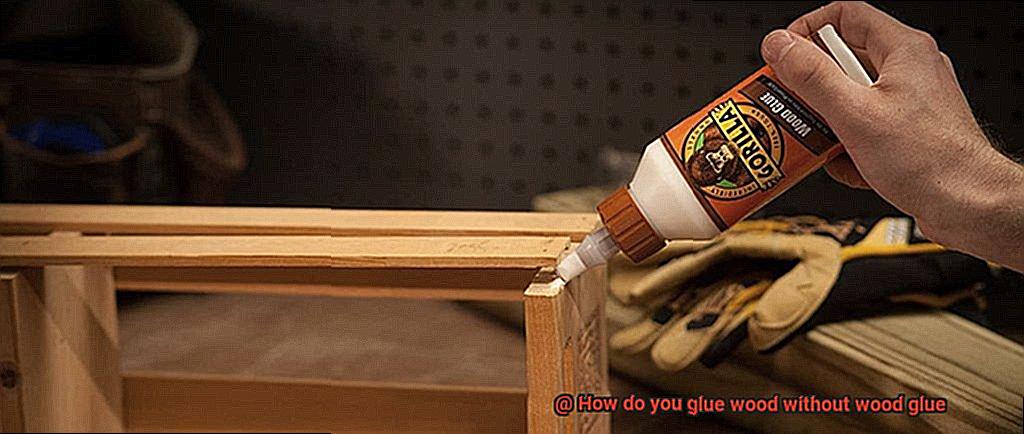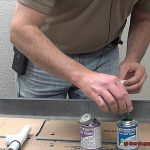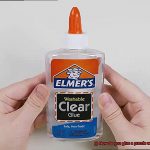As a woodworking enthusiast, you know that wood glue is the go-to adhesive when it comes to joining pieces of wood together. But what happens when you run out or can’t find it? Don’t panic. There are other ways to glue wood without wood glue. From natural alternatives to surprising household items, there are plenty of options available that can create a sturdy and lasting bond between pieces of wood.
One of the most popular natural alternatives is hide glue, which has been used for centuries and is still favored by many professional woodworkers today. Another natural option is egg white, which can create a strong bond and is often used for delicate or small parts.
But did you know that toothpaste or baking soda can also be used as adhesives? It may sound bizarre, but mixing toothpaste with baking soda can create a strong hold for lightweight objects. Similarly, combining equal parts baking soda and water creates a paste that can be used to fill small gaps and holes in wood.
In this blog post, we’ll dive deeper into the various ways you can glue wood without using traditional wood glue. We’ll explore the benefits and drawbacks of each method, as well as provide tips and tricks to ensure a successful bond. With these alternatives at your disposal, you won’t miss a beat on your woodworking projects.
What is Wood Glue and Why Do We Use it?
Contents
Wood glue, also known as carpenter’s glue or PVA glue, is a type of adhesive that is specifically designed for use on wood. It is made from a combination of synthetic polymers and water, which create a strong bond when they dry.
But what makes wood glue so important and why do we use it?
- Creates Strong Bonds: One of the primary benefits of using wood glue is that it creates a very strong bond between pieces of wood. Whether you are building furniture or constructing a wooden structure, you need to ensure that the end result is strong and durable. Wood glue ensures that the pieces of wood stay together securely and don’t break apart easily. You can also use it to fill gaps and cracks in wood, making it a versatile tool in the workshop.
- Dries Clear: Another benefit of using wood glue is that it dries clear, which can be important for certain projects where aesthetics are important. This allows the natural beauty of the wood to shine through without any visible traces of glue. It’s perfect for projects where you want to highlight the natural grain and texture of the wood.
- Water-Resistant: Most types of wood glue are water-resistant, which can be helpful for outdoor projects or items that will be exposed to moisture. This ensures that the bond between the pieces of wood remains strong even when exposed to different weather conditions. It’s ideal for building outdoor furniture or structures that will be exposed to the elements.
While other types of adhesives are available for use on wood, such as epoxy and cyanoacrylate glue, wood glue remains one of the most popular and effective options on the market today. However, different types of wood require different types of glue, so it’s important to choose the right adhesive for your specific project needs.
Alternative Adhesives for Gluing Wood
While traditional wood glue might be the go-to adhesive for most woodworking projects, there are plenty of alternative adhesives available that come with their unique advantages.
One such adhesive is epoxy resin, a two-part adhesive known for its strength and durability. If you’re working on heavy-duty woodworking projects such as furniture or boat building, epoxy resin is perfect for you. However, its longer drying time might not be ideal if you’re in a hurry.
For small woodworking projects such as repairing cracks or joints, cyanoacrylate glue, also known as superglue, is an excellent alternative. It dries quickly and forms a strong bond, but it may not be as durable as other adhesives and may not work well on larger surfaces.
If you’re working on outdoor woodworking projects, polyurethane glue might be the best alternative adhesive for you. This expanding adhesive fills gaps and creates a strong bond while being resistant to water and weathering. However, it takes longer to dry than traditional wood glue and requires clamping during the drying process.
Hide glue is another alternative adhesive that has been used in woodworking for centuries. It creates a strong bond that can easily be reversed with heat, making it ideal for antique restoration projects. However, it has a shorter shelf life than other adhesives and may not be suitable for all types of woodworking projects.
Epoxy Resin
Look no further than epoxy resin. This two-part adhesive consists of a resin and a hardener that chemically react to create a strong, durable bond. As an expert on this subject, I can tell you that epoxy resin is a powerhouse adhesive that can bond a variety of surfaces such as wood, metal, and plastic.
One major advantage of using epoxy resin is its versatility. Not only can it be used on various materials, but it also has water-resistant properties and can withstand exposure to heat and chemicals. This makes it the perfect choice for those who need an adhesive that can withstand harsh conditions.
To use epoxy resin for wood bonding, the first step is to prepare the surfaces by sanding them down to create a rough texture. Then, mix the two parts of the epoxy together according to the manufacturer’s instructions. Apply the mixture to one of the surfaces before pressing the two pieces of wood together firmly. Any excess epoxy should be wiped away with a clean cloth.
However, it’s important to note that there are some disadvantages to using epoxy resin. It tends to be more expensive than traditional wood glue and has a longer drying time. Additionally, it requires precise mixing ratios and can be messy if not applied carefully.
Despite these drawbacks, I still highly recommend giving epoxy resin a try for your next woodworking project. With its ability to create a strong bond that can withstand even the toughest conditions, it’s definitely worth the investment.
Cyanoacrylate Glue (Superglue)

Cyanoacrylate glue is a popular choice for small woodworking projects and repairs due to its quick bonding time. This adhesive is perfect for those moments when you need to fix something quickly and get back to your workbench. However, it may not be suitable for larger projects or those that require a stronger bond.
To use cyanoacrylate glue for woodworking, start by ensuring the surfaces to be bonded are clean and dry. Then, apply a small amount of the glue to one surface and press the two surfaces together firmly. Hold them in place for a few seconds to allow the glue to bond. Voila. It’s that easy.
Before you start gluing away, it’s important to take safety precautions. The fumes from the glue can be harmful if inhaled, so make sure you’re working in a well-ventilated area and avoid breathing in the fumes. Additionally, it’s advisable to wear gloves to protect your skin from accidental contact with the glue.
While cyanoacrylate glue can be an effective solution for small woodworking projects or repairs, it’s important to understand its limitations. This adhesive can be brittle and may not hold up well under stress or pressure. Thus, for larger projects or those that require a stronger bond, you may want to consider other adhesives.
Polyurethane Glue
Attention fellow woodworkers. Are you tired of using the same old traditional wood glue? Looking for something that’s just as strong and versatile, but with a little more oomph? Look no further than polyurethane glue.
Polyurethane glue, also known as Gorilla Glue, is a popular choice among carpenters and woodworkers for its unique properties. It works by reacting with moisture in the air or in the material being glued, causing it to expand and foam. This creates an incredibly strong and durable bond that can be used on a variety of surfaces, including wood, metal, plastic, and even stone.
One of the biggest advantages of polyurethane glue is its ability to fill gaps and cracks between surfaces. This makes it ideal for repairing damaged wood or even creating new woodworking projects. Plus, it has a longer working time than traditional wood glue, which allows for more precise application and adjustments to be made before the glue dries.
But as with any product, there are a few things to keep in mind when using polyurethane glue. It can be difficult to remove if it gets on your skin or other surfaces, so be sure to wear gloves and work carefully. Additionally, clamping during the curing process is necessary to ensure a strong bond. And finally, remember that it expands quite a bit during curing, so use caution when applying it.
Hide Glue
It’s time to switch things up and try hide glue – the natural superhero of adhesives.
Derived from collagen, a protein found in animal hides and bones, hide glue has been used for centuries to bond wood and other materials. It comes in a variety of forms, including granules, liquid, and pre-made glue sticks. While it may not be as convenient as modern wood glues, it offers a unique set of benefits that have kept woodworkers loyal for generations.
One of the most notable benefits of hide glue is its longer open time. Unlike modern synthetic adhesives, hide glue gives woodworkers more time to adjust and position their pieces before the glue sets. And if mistakes are made or repairs are needed later on, hide glue can be easily reversed with heat and moisture.
The process for using hide glue may seem a bit old-fashioned but it’s actually quite simple. First, you’ll need to heat the glue to a specific temperature depending on the type of glue you’re using. This can be done with a glue pot or a double boiler. Once heated, apply it to one surface of the wood and clamp it together with the other piece. The glue will begin to set as it cools down and dries completely within 24 hours.
But wait, there’s more. Hide glue is also eco-friendly and biodegradable, making it an attractive option for those concerned about the environmental impact of their woodworking projects. It’s a natural adhesive that has stood the test of time and remains relevant today.
Advantages and Disadvantages of Alternative Adhesives
It can be overwhelming to choose from the variety of options available. As an expert on the advantages and disadvantages of alternative adhesives, I’m here to help you make an informed decision.
Let’s start with epoxy, a favorite among woodworkers for its strength and durability. This two-part adhesive can bond well to both porous and non-porous materials, making it a versatile choice. However, be warned – epoxy can be quite messy to work with and requires careful mixing to avoid air bubbles.
If you’re looking for a quick-setting adhesive for small projects or repairs, cyanoacrylate glue (aka superglue) may be the perfect fit for you. It can bond well to wood and other materials but may not provide sufficient strength for larger or heavier projects.
Polyurethane glue is another option that can fill gaps between pieces of wood and form a strong bond. However, this adhesive requires careful application as it can expand as it cures, potentially causing issues if not applied correctly. The curing time is also longer than other adhesives.
For those who prioritize eco-friendliness, natural adhesives like hide glue and animal-based glues such as fish glue or rabbit skin glue are great alternatives. These adhesives have been used for centuries and offer a sustainable option. However, they require special preparation or equipment and can be more difficult to work with.
When choosing an alternative adhesive, it’s crucial to consider your specific project needs. Factors such as strength, durability, ease of use, and environmental impact should all be taken into account before making a decision.
Tips for Successful Gluing Without Wood Glue
There are alternative methods available. Here are five tips for successful gluing without wood glue:
Choose the Right Type of Glue
Selecting the correct adhesive for the task at hand is crucial. Epoxy resin, cyanoacrylate glue (superglue), polyurethane glue, and hide glue are all viable alternatives to traditional wood glue. It’s important to choose the one that suits your project’s needs.
Prepare the Wood Surfaces
Before applying any adhesive, ensure that the surfaces you want to bond are clean and dry. Sanding the surfaces can also increase the surface area for the glue to adhere to, resulting in a stronger bond.
Apply Adhesive Evenly and Sparingly
Applying the adhesive evenly and sparingly is critical to avoid a weak bond and excess mess. Applying too much glue can lead to a weak bond and make a mess that is difficult to clean up.
Clamp the Pieces Together
Clamping the pieces together during the drying process can help ensure a strong bond. However, it’s important not to apply too much pressure as it can damage the wood.
Allow Adequate Drying Time
Depending on the type of adhesive used, drying time can vary from a few hours to several days. It’s crucial to be patient and allow sufficient time for the adhesive to dry completely. Rushing the process can result in a weaker bond or complete failure.
ZASe8XzxbV4″ >
Also Read: How to Glue Wood to Brick?
Conclusion
As a passionate woodworking enthusiast, it’s crucial to explore the many ways you can glue wood without relying on traditional wood glue. Whether you’re looking for natural alternatives or unexpected household items, there are plenty of options available that can create a strong and long-lasting bond between pieces of wood.
Although wood glue remains a popular and effective choice, different types of wood require different types of adhesive. Therefore, it’s essential to choose the right product for your specific project needs. From epoxy resin to cyanoacrylate glue (also known as superglue), polyurethane glue, and hide glue, each alternative adhesive offers unique advantages and disadvantages that must be considered before making a decision.
It’s also crucial to take safety precautions when using any adhesive and follow the manufacturer’s instructions carefully. To ensure successful gluing without wood glue, prepare the surfaces properly, apply adhesive evenly and sparingly, clamp the pieces together during drying time, and allow adequate drying time depending on the type of adhesive used.
With these tips in mind and alternative adhesives at your disposal, you’ll be able to tackle any woodworking project with ease. So why limit yourself to traditional wood glue when there are so many other options available?






